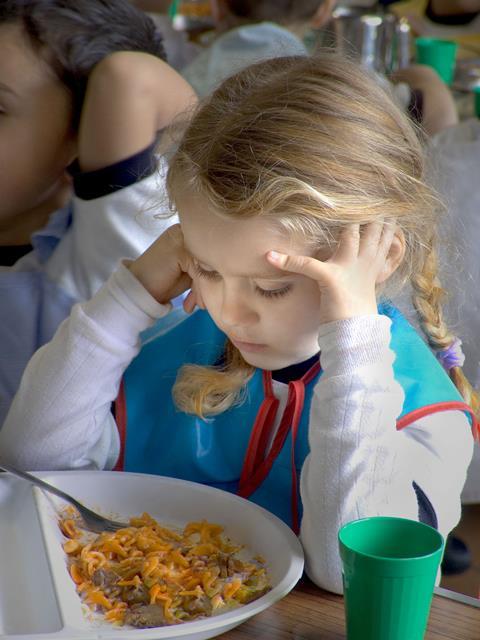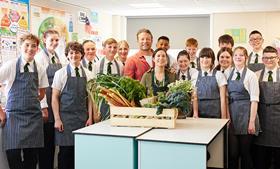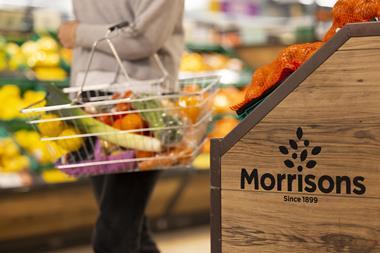School dinners. For many Brits, the mere mention of those words conjures bad memories of unidentified brown sludge, lumpy custard and perhaps even the infamous Turkey Twizzlers. Some experienced just such a flashback earlier this year, when headlines across the country were awash with the righteous anger of headteacher Jason Ashley from Redbridge Community School in Southampton.
“The food that’s served is completely unacceptable,” began Ashley’s public shaming of the school’s catering company Chartwells. “If my children’s school served this, I would be exceptionally unhappy.”
Ashley’s outburst struck a chord. Innumerable conversations followed, from newspaper columns to school playgrounds, recalling the dire state of the food being served up in the nation’s schools. Yet there are also many exceptions. As shown by Jamie Oliver’s Good School Food Awards, whose winners were announced on 20 June, some schools are providing pupils with excellent meals every day.
Indeed, the awards are proving that outstanding meals are not only possible, but they could even become the norm if the right steps are taken. So, how is it possible that some schools are feeding pupils excellent food, while others are offering dross? What are great schools doing differently? And as Brits head to the polls, what policies and programmes need to be put in place to future-proof great school food?
As the shocking food on offer at Redbridge proved, a revision of the national standards – the School Food Regulations were introduced in 2014 and revised in January 2015 – is long overdue. And when looking at the big picture, rarely is the disparity clearer than between primary and secondary schools.
While primary is delivering “relatively well as a baseline”, according to Naomi Duncan, CEO of Chefs in Schools, a charity that delivers training to help schools serve better food, the grab-and-go approach in many secondary schools lets unhealthy snacks and food slip through the cracks.
Where does each party stand on school food standards and access?
The Green Party
- Pledges to give all school children a free meal every day and free breakfast clubs up to year six. The party manifesto also emphasises teaching children about food, including how to grow and cook it.
The Liberal Democrats
- Want to provide free school meals for “all children in poverty”, with the long-term goal to extend it to all primary school children “when the public finances allow”.
Labour
- Pledges to introduce free breakfast clubs in every primary school. The manifesto references tackling childhood obesity by banning the advertising of junk food.
The Conservatives
- Make no mention of school food standards, free school meals or food education training. The manifesto mentions tackling childhood obesity by restricting HFSS foods advertising.
Measurement and monitoring
However, even sweeping improvements to standards are little use without proper monitoring, adds Stephanie Slater, CEO of charity School Food Matters.
“In 2013, we had a chapter in the School Food Plan called ‘What gets measured gets done’, stressing the importance of monitoring school food,” she says. “Unless someone’s looking at the food served in schools, there’s no opportunity to spot problems and fix them. Unfortunately, this action from the plan wasn’t delivered, but there’s some hope, with interesting ideas about monitoring being explored by the FSA.”
Before being forced to close in 2017 due to lack of funding, the Children’s Food Trust advised schools, caterers, families and the government on school food, with much of that advice informed by the collection of data through the National Indicator (NI) 52. The NI 52 asked local authorities, among others, for data about school food take-up for both free and paid meals and was instrumental in flagging problems or gaps within the system.
When Slater founded School Food Matters in 2007, she was able to campaign on school meals because the NI 52 showed that only 26% of children in her London borough were taking up a school meal – a key indicator of a problem to be addressed.
“It’s about taking concrete steps that create a level playing field for caterers and providers”
She says the monitoring should measure school meals take-up, nutritional quality, morale of workforce, and the proportion of schools with a quality award, for example from the Food for Life partnership. Responsibility for enforcing these measures would be shared between Ofsted, whose inspectors would do the checks, and the Department for Education, which would measure progress against set targets.
As an example, fewer pupils taking up school meals in an area could be an alert to the quality of the food but also show where local authority budget could increase.
Slater has been pushing for such monitoring to return. “It’s been a very turbulent time in politics in recent years, but we’re hopeful that post-election, we can get this initiative across the line,” she says.

Exacerbating the situation is the pressures felt by both schools and school food providers due to inflation and lack of funding. Since 2010/11, government funding decisions have resulted in 70% of maintained schools in England facing real-terms cuts to their finances.
Quality is obviously going to be affected when cash-strapped schools are forced to “do many things with less and less money”, says Slater. “Understandably, school food can fall to the bottom of a very long list.”
Ringfencing contracts
The Federation of Wholesale Distributors raised concerns about the lack of ringfenced budgets for current school food contracts in a submission to the Competition & Markets Authority last year, calling for the government to enforce quarterly price reviews to reflect inflation, which hit 19% in early 2023.
According to the FWD, when faced with rising costs, wholesalers had to swap to cheaper ingredients and reduce UK-grown and produced product – going directly against the government’s stated aims. This was certainly the case for two wholesalers fulfilling public contracts across the UK: Brakes and Bidfood.
Gavin Squires, business development controller for education at Bidfood, feels that “the allocation of funding by the current government has been the main reason for this disparity” between meals at different schools. “It’s a shame some of the good work achieved by wholesalers on local sourcing, menu choices, and culinary creativity has taken a few steps back as a result of price and cost pressures,” he adds.
Supplying the education sector in the north of England makes up 65% of Dunsters Farm’s foodservice business. “Last year, food inflation alone was bigger than the increase in school funding for over a decade,” says commercial director Tom Mathew. “We’re essentially asking local authorities, schools and food providers to do the impossible.
“Looking at the bigger picture, it’s not councils and local authorities that create the disparity in quality. It’s a question at central government level of how much, as a country, we value the role of school meals.”
For the 900 schools tied into PFI (private finance initiatives) contracts, the situation is even worse. PFI was introduced by the Conservative government in the 1990s and saw schools in England built by private companies – which retained responsibility for various day-to-day aspects, including catering, for up to 30 years.
Indeed, Redbridge Community School’s Ashley’s viral tirade was aimed at the food from Chartwells’ private catering firm – imposed on his school via its PFI contract.
“If there was more openness [about PFI contracts], the publicity would shock many citizens and taxpayers,” MP Meg Hillier, former chair of the Public Accounts Committee of MPs, told the BBC earlier this year. “And that might push the companies to think again and make sure they’re not wringing every last penny out of our school system.”
What are schools cooking great meals doing?
There are exceptions, however. Helena Honeybone, headteacher at Town Field Primary School in Doncaster, won School Leader Food Hero at the Jamie Oliver Good School Food Awards last year.
“The secret is working with our catering company to use local produce to make dishes that taste delicious,” she says. “We also ask the children their likes and dislikes, so we can create a menu that’s attractive to them.”
Using only local produce could be a restriction for many, but Honeybone sees it as an opportunity to focus on seasonal ingredients and keep a close eye on freshness, which is often the first element to be ignored when school canteens run into trouble, financial or otherwise – and can often be key in take-up by pupils.
“We’re essentially asking local authorities, food providers and schools to do the impossible”
For Tilly Browne and Rebecca Owen, co-headteachers of Reach Academy in Feltham, London, which won the Catering Team Champions award this year, the solution lies in giving pupils a “family style” meal in which everyone gets the same – with food served in the middle of each table and children helping themselves. By putting on a unified offer, the school is able to tackle both budget and food waste efficiently.
“Most schools offer three or four options. We decided not to, because preparing the same nutritious meal across the school is more efficient and encourages pupils to try new foods together,” says Browne.
“A key aspect is that all our food is freshly prepared and delivered on a large scale, because everyone here has free school meals. And initiatives like the Mayor of London’s meal funding in primary have definitely alleviated some of the pressure.”
Great leadership makes for great school food, says Slater. “What we found back in 2013, when I worked on the school food plan with Henry Dimbleby, is that in every school that’s doing a brilliant job there’s a senior leader who’s leading the charge.”
Of course, behind great school leaders there are often great caterers, as is the case at Reach Academy. “Just because you’re cooking for a school, it doesn’t mean the food should be any less tasty or complex,” says winning chef Hugo, who runs the school’s kitchen.
“When Jamie [Oliver] first started his campaign work, there were standards for dogfood but not for school food,” recalls Alison Corfield, head of sustainability at The Jamie Oliver Group. “We’ve come a long way, but our school system is the biggest restaurant chain in the country, feeding our kids 190 days a year – our goal is to treat it as the most loved one, too.”
Free school meals: who qualifies?
As well as differing standards, there’s differing qualifications. Scotland, Wales and, most recently, London are all proving free school meals for every student is possible if the political will exists. In the rest of England the rules on qualifying are “draconian”, with lots of restrictions, including a threshold of less than £7,400 in household income. Offering universal access would help solve the school dinners puzzle, experts argue.
“The main reason the system’s falling down in places is that it doesn’t offer the same thing to everybody,” says Corfield. “When universality is not part of the picture, caterers are forced to have different relationships with different people. We know school food works better when we have [the same] standards for all.”
Slater agrees universality is key. “The only way we can advocate for better food is by making it accessible to all,” she says. “We know there’s a cost to it, but we also know the economic returns outweigh the investment.”

According to calculations from PwC, for every £1 invested in school food for all, £1.71 is eventually returned to the wider economy. And when wider benefits such as reduced health spending are considered, free school meals for all pupils would generate £99.5bn for the UK economy over 20 years, it calculates.
“The next step is for the government to follow the lead of London, Scotland and Wales by expanding this policy to all children in England,” adds Slater.
But that’s just the beginning. Even if and when standards are updated, having motivated and well-trained people to cook great food will be crucial. For Chefs in Schools’ Duncan, that process starts with empowering the 80,000-strong workforce dishing up school meals every day.
“It should come from the government to mandate that people who work in school kitchens have to be trained around food standards and child nutrition – and to allocate funding for that,” she says.
“In the long term, we need an accreditation scheme that every school in the country has to be signed up to. It’s about taking concrete steps that create a level playing field for caterers and providers,” she adds.
School Food Matters’s manifesto also advocates for the appointment of a professional school food improvement officer for every local authority. They would help schools develop a ‘whole school’ approach to food that ranges from supporting with food policy to liaising with local authorities on food tenders.
Fortunately for campaigners, with a new government in the offing, there is an opportunity to bring school food to the fore again, especially with the majority of parties mentioning school food in their manifestos.
“I’m optimistic that a new government will see the value of investing in children’s health and wellbeing, scrap the draconian threshold [for free school meals] and offer school food for all,” says Slater.
“There are such wildly different food standards between different schools, primarily due to a lack of monitoring and under-investment in the service. If the government is serious about tackling this, it needs a whole systems approach: fairer funding, equitable access and quality assurance. It will take bold leadership but will reap the rewards of well-nourished children who are ready to learn and reach their full potential.”
Introducing the Jamie Oliver’s Good School Food Awards winners 2024

Catering Team Champions Award
Chef Hugo and the catering team at Reach Academy Feltham have won for nourishing every child aged two to 18 every day with creative, delicious food. “I’m impressed by the holistic approach taken to promote healthy eating,” said celebrity judge Ellie Simmonds.

Rising Star Award
Pokesdown Primary School in Bournemouth won thanks to chef Russ and his team’s approach, delivering over 300 fresh meals daily made from scratch. “The combination of delicious food, hands-on education and community involvement is a winning recipe,” said celebrity judge Jermaine Jenas.

Food Educator of the Year Award
Michelle Woodard, teacher at King Edmund School in Rochford, Essex, won the Food Educator of the Year Award for her dedication to promoting nutrition, cooking skills, and healthy meal prep. “I believe the skills we’re teaching them [lead to them] being able to make themselves healthy meals, and cook for family and friends.”

Sustainability Star Award
North Ridge High School Sixth Form Hub in Manchester won the Sustainability award for their innovative projects, including their ‘From Plot to Plate’ catering company and fully meat-free menu. “Their dedication to sustainability education and real-life practice is remarkable, and their initiatives are shining examples of what can be achieved,” said Jamie Oliver.

School Leader Food Hero Award
Natalie Hackett, headteacher at New Lubbesthorpe Primary School in Leicestershire, won for her work training staff and volunteers about nutrition and enriching the school’s food curriculum, including the ‘Beans Meal Project’ that linked pupils with farms, scientists, and growers. “I hope my achievements show how schools and communities can work together to create wonderful opportunities around food,” she said.

Kindness and Community Award
Naomi Parkinson, teacher at Ingol Community Primary School in Preston, won due to her transformative efforts on her school’s food culture, bringing catering in-house for the first time and making meals more affordable. “Naomi’s efforts have truly transformed the school and made a meaningful impact,” said celebrity judge Big Has.

Food for Fuel Award
Jen Craven, teacher at Ysgol Trefonnen in Powys, Wales, won for her work tackling holiday hunger, and fostering community fitness initiatives. “Jen is helping elevate the health and fitness of the school,” said judge Joe Wicks.

Youth Activist of the Year Award
Madie Toplass, year 11 student at Thistley Hough Academy in Stoke-on-Trent, won thanks to her entrepreneurial spirit hosting bake sales, and volunteering within community food banks. “Madie does so much incredible work in and out of school,” said celebrity judge and ambassador for people with Down’s syndrome George Webster.




















No comments yet